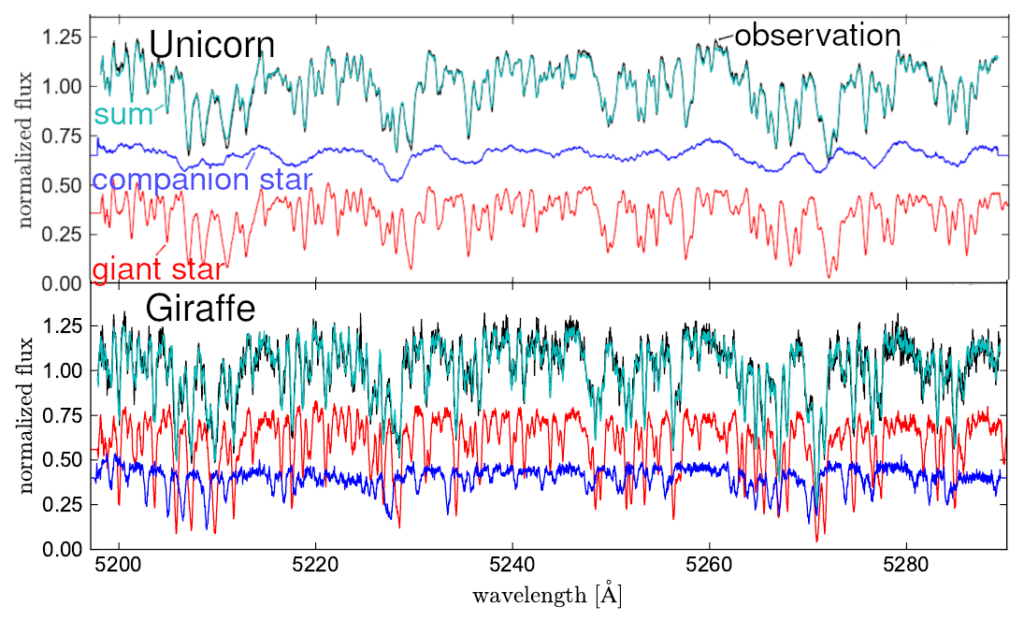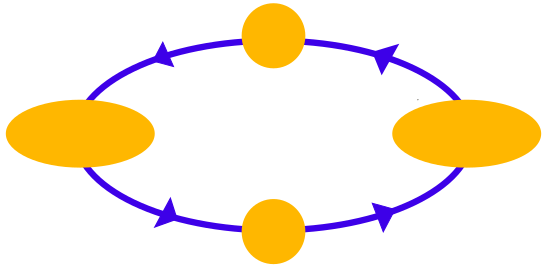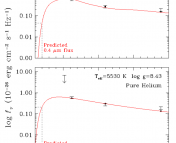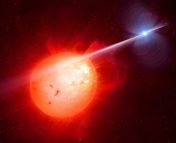Title: Unicorns and Giraffes in the binary zoo: stripped giants with subgiant companions
Authors: Kareem El-Badry, Rhys Seeburger, Tharindu Jayasinghe, Hans-Walter Rix, Silvia Almada, Charlie Conroy, Adrian M. Price-Whelan, Kevin Burdge
First Author’s Institution: Center for Astrophysics, Harvard & Smithsonian, Cambridge, USA
Status: Accepted to MNRAS
Have you ever wondered why giraffes exist, but unicorns don’t? Let me tell you a secret: there is a place where both giraffes and unicorns exist – in the night sky! Both animals can be found as constellations. The constellations Unicorn and Giraffe have something in common: they both contain a binary system with special properties.
The binary in the constellation Unicorn is called V723 Mon, while the one in the Giraffe is called 2M04123153+6738486. Oh dear, these names are difficult to keep track of, right? Apparently, so thought the authors of today’s paper. Therefore, they simply named the binary star systems after their constellations: the Unicorn and the Giraffe. Much more intuitive!
What is so special about the Unicorn and the Giraffe?
Both binary systems contain a red giant star, which is an evolved stage of a “normal” or main sequence star. A red giant occurs when a main sequence star has burned up its hydrogen fuel for nuclear fusion. At this point, its envelope starts to grow up to a hundred times of its initial radius while its temperature decreases, making it “redder” (hence the name). But let’s get to the unusual part: in both systems, the giant orbits a companion that is about five times more massive than the giant. But this massive companion is much fainter than the giant! This is unusual because more massive stars usually shine brighter than less massive ones. The companions in both systems are of unknown nature, because it’s really hard to observe a faint object next to a bright one, as the bright outshines the light of the faint.
The companions have previously been classified as a small black hole (see this astrobite for the Unicorn) because of their high mass and lack of luminosity. However, the authors of today’s paper have reason to believe otherwise. Therefore, they re-analyze the data of both the Unicorn and the Giraffe.
Is the companion really a black hole?
There is something suspicious about the spectra of the two systems: when fitting a spectrum of a single star to the observed data and looking at the residuals (“left-overs” when subtracting the fit from the data), the residuals showed absorption lines. This is an indication that the fainter companion is a star instead of a compact object like a black hole, because absorption lines are a sign for a thick and light absorbing atmosphere or gas cloud around the object. However, it can’t be a main sequence star, because the residuals are very low in the UV wavelength range, but would be larger for a main sequence star. This is why the authors suspect the companion to be a subgiant star, a star just entering the giant stage.
Disentangling the Unicorn and the Giraffe
Instead of fitting a single star spectrum and taking the residuals, the authors of today’s paper fit a binary spectral model to the data. This approach is more accurate, because the best-fitting single star spectrum can be very different from the spectra of each binary component. The authors then use a method called spectral disentangling. Using an algorithm, this method disentangles the spectrum of a binary, which is the sum of two Doppler shifted components. The authors can successfully recreate the spectra of the Unicorn and the Giraffe with contributions from a giant and a subgiant companion star, as shown in Figure 1.


To investigate their hypothesis further, they analyze the light curve of the red giant. A light curve shows a sinusoidal shape if a star is deformed to an ellipsoidal instead of a sphere from the gravitational pull of a massive companion object. This effect is called ellipsoidal variability and occurs because an ellipsoidal object shows different sides while it orbits, as pictured in Figure 2. The ellipsoid shows its side twice per orbit (left and right) and its face also twice (front and back). Because the visible area is larger when the ellipsoid shows its side, the light curve shows two maxima and two minima per orbit.
Previous works have already shown that the light curves of the Unicorn’s and Giraffe’s red giant display an ellipsoidal variability. For a start, this tells us that the red giant is bloated so that its Roche lobe, the area where material is gravitationally bound to the star, is filled with the star’s material. This indicates a mass flow from the giant onto the companion. The giant currently gets stripped of its material, a rarely observed stage of a binary system. This is one of the reasons making the two systems very valuable.
The authors fit the light curve of the giants using a model with a subgiant companion and compare it to a model with a black hole companion (see Figure 3 for the Giraffe). They find that the subgiant companion fits the observed data better, especially the difference in depth of neighboring minima. This difference occurs due to gravity darkening, a phenomenon making the poles of a star are brighter than the equator.
What will the future hold?
In addition to analyzing the observational data, the authors of today’s paper investigate the evolution of both systems in simulations. This way, they can look into the binaries’ past, but also see their futures. The authors find the best initial conditions to recreate the systems in the present and discover that they will most likely end up as compact white dwarf binary systems. Both Giraffe and Unicorn will continue to exist and likely have an exciting future!
Astrobite edited by Lindsay DeMarchi
Featured image credit: NASA, ESA, and F. Paresce (INAF-IASF, Bologna, Italy), R. O’Connell (University of Virginia, Charlottesville), and the Wide Field Camera 3 Science Oversight Committee and https://www.pngwing.com/en/free-png-thlmb





Why didn’t the more massive companion move off the main sequence first. Wouldn’t that normally be the case?
Yes, that is correct! Thank you for your very attentive question. The authors argue that the initial mass ratio of the stars was close to 1 (which means that the stars started off with the same mass). Therefore, they left the main sequence almost at the same time. The star that left the main sequence a tiny bit earlier became a red giant first, transferring its mass onto the companion star (and therefore “delaying” the evolution of the companion). This is how the systems most likely ended up in this configuration and it’s also what the authors find in their evolution simulations that are mentioned at the end of the article.